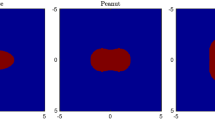Abstract
In this chapter, hybrid method for solving two-dimensional inverse scattering problems is illustrated. In this method, a two-step optimization-based routine is used in which direct and expansion methods are utilized simultaneously to obtain more precise and fast reconstruction. In the first step, a coarse solution is achieved with the help of truncated cosine Fourier series expansion method. Then, with this solution as an initial guess for the second step, direct optimization is used to obtain a much more accurate solution of the problem. In both steps, finite difference time domain and differential evolution are used as an electromagnetic solver and global optimizer, respectively. The most important advantage of this method is that because of a suitable initial answer in direct optimization routine, sensitivity of the algorithm to the regularization parameter is decreased and convergence of the results is completely guaranteed. Performance of the proposed method is demonstrated for several two-dimensional relative permittivity profile reconstruction cases.
Access this chapter
Tax calculation will be finalised at checkout
Purchases are for personal use only
Similar content being viewed by others
References
T. J. Cui, W. C. Chew, X. X. Yin, and W. Hong, Study of resolution and super resolution in electromagnetic imaging for half-space problems, IEEE Transactions on Antennas and Propagation, vol. 52, no. 6, pp. 1398–1411, 2004.
M. Donelli, G. Franceschini, A. Martini, and A. Massa, An integrated multiscaling strategy based on a particle swarm algorithm for inverse scattering problems, IEEE Transactions on Geoscience and Remote Sensing, vol. 44, no. 2, pp. 298–312, 2006.
M. Popovic and A. Taflove, Two-dimensional FDTD inverse-scattering scheme for determination of near-surface material properties at microwave frequencies, IEEE Transactions on Antennas and Propagation, vol. 52, no. 9, pp. 2366–2373, 2004.
I. T. Rekanos and A. Raisanen, Microwave imaging in the time domain of buried multiple scatterers by using an FDTD-based optimization technique, IEEE Transactions on Magnetics, vol. 39, no. 3, pp. 1381–1384, 2003.
M. Donelli and A. Massa, Computational approach based on a particle swarm optimizer for microwave imaging of two-dimensional dielectric scatterers, IEEE Transactions on Microwave Theory and Techniques, vol. 53, no. 5, 1761–1776, 2005.
A. Semnani and M. Kamyab, An enhanced method for inverse scattering problems using Fourier series expansion in conjunction with FDTD and PSO, Progress in Electromagnetics Research, vol. 76, pp. 45–64, 2007.
A. Semnani and M. Kamyab, Truncated cosine Fourier series expansion method for solving 2-D inverse scattering problems, Progress in Electromagnetics Research, vol. 81, pp. 73–97, 2008.
A. Semnani and M. Kamyab, An enhanced hybrid method for solving inverse scattering problems, Thirteenth Biennial IEEE Conference on Electromagnetic Field Computations (IEEE CEFC 2008), Athens, Greece, May 2008.
A. Taflove and S. C. Hagness, Computational Electrodynamics: The Finite-Difference Time-Domain Method, 3rd ed., Artech House, Norwood, MA, 2005.
R. Storn and K. Price, Differential evolution – a simple and efficient heuristic for global optimization over continuous space, Journal of Global Optimization, vol. 11, no. 4, pp. 341–359, 1997.
A. Abubakar and P. M. Van Den Berg, Total variation as a multiplicative constraint for solving inverse problems, IEEE Transactions on Image Processing, vol. 10, no. 9, pp. 1384–1392, 2001.
Acknowledgments
This work was supported by the Iran Telecommunication Research Center (ITRC) under contract no. T-500-10528.
Author information
Authors and Affiliations
Corresponding author
Editor information
Editors and Affiliations
Rights and permissions
Copyright information
© 2010 Springer-Verlag New York
About this chapter
Cite this chapter
Semnani, A., Kamyab, M. (2010). A Hybrid Method for Solving 2-D Inverse Scattering Problems. In: Sabath, F., Giri, D., Rachidi, F., Kaelin, A. (eds) Ultra-Wideband, Short Pulse Electromagnetics 9. Springer, New York, NY. https://doi.org/10.1007/978-0-387-77845-7_9
Download citation
DOI: https://doi.org/10.1007/978-0-387-77845-7_9
Published:
Publisher Name: Springer, New York, NY
Print ISBN: 978-0-387-77844-0
Online ISBN: 978-0-387-77845-7
eBook Packages: Physics and AstronomyPhysics and Astronomy (R0)




